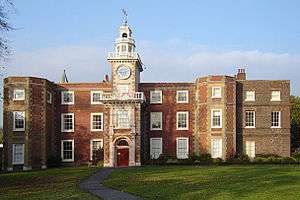
Bruce Castle
Bruce Castle (formerly the Lordship House) is a Grade I listed 16th-centurymanor house in Lordship Lane, Tottenham, London. It is named after the House of Bruce who formerly owned the land on which it is built. Believed to stand on the site of an earlier building, about which little is known, the current house is one of the oldest surviving English brick houses. It was remodelled in the 17th, 18th and 19th centuries.
The house has been home to Sir William Compton, the Barons Coleraine and Sir Rowland Hill, among others. After serving as a school during the 19th century, when a large extension was built to the west, it was converted into a museum exploring the history of the areas now constituting London Borough of Haringey and, on the strength of its connection with Sir Rowland Hill, the history of the Royal Mail. The building also houses the archives of the London Borough of Haringey. Since 1892 the grounds have been a public park, Tottenham's oldest.
Origins of the name
The name Bruce Castle is derived from the House of Bruce, who had historically owned a third of the manor of Tottenham. However, there was no castle in the area, and it is unlikely that the family lived nearby. Upon his accession to the Scottish throne in 1306, Robert I of Scotland forfeited his lands in England, including the Bruce holdings in Tottenham, ending the connection between the Bruce family and the area. The former Bruce land in Tottenham was granted to Richard Spigurnell and Thomas Hethe.
Bruce Castle (rugby league)
Bruce Castle is a New Zealand rugby league player who represented his country.
Playing career
Castle played for the Ellerslie Eagles. In 1966 he won the Rothville Trophy as the Auckland Rugby League competition player of the year.
He also represented Auckland and was part of victories over Australia in 1961 and Great Britain in 1962.
Castle played two test matches for the New Zealand Kiwis, including one as captain.
Coaching career
Castle was the player-coach for Turvey Park in Wagga Wagga before coaching the Mangere East Hawks in the Auckland Rugby League competition.
Later years
Castle was a selector for the New Zealand Kiwis between 1999 and 2001.
Personal life
Castle's daughter, Raelene, is a sports administrator and has served as the Chief Executive Officer of Netball New Zealand and the Canterbury-Bankstown Bulldogs.
References

Bruce Castle School
Bruce Castle School, at Bruce Castle, Tottenham, was a progressive school for boys established in 1827 as an extension of Rowland Hill's Hazelwood School at Edgbaston. It closed in 1891.
Origins
In 1819, Rowland Hill moved his father's Hill Top School from central Birmingham, establishing a new school called Hazelwood at Edgbaston, an affluent suburb, as an "educational refraction of Priestley's ideas". Hazelwood soon became a model for the education of the new middle classes, aiming to give sufficient knowledge and skills to enable a boy to continue self-education throughout a life "most useful to society and most happy to himself". The new school, which Hill designed himself, had both a science laboratory and a swimming pool. In his Plans for the Government and Liberal Instruction of Boys, Hill argued that kindness, instead of corporal punishment, and moral influence, rather than fear, should be to the fore in school discipline. Science should be a compulsory subject, and boys were to be self-governing. Hazelwood School gained international attention when Marc Antoine Jullien visited the school and wrote about it in the issue of Revue encyclopédique for June 1823, then sent his own son there.
Podcasts:

